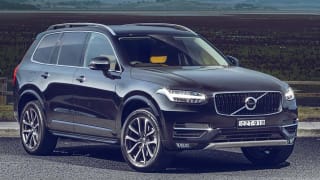
Volvo XC90 TwinCharged 2015 review
Joshua Dowling road tests and reviews the Volvo XC90 at its Australian launch.
Browse over 9,000 car reviews
Porsche hybrid is full of clever tech but it feels like driving Miss Daisy.
Cayenne drivers are a selfless lot. They drive boring SUVs so that other Porsche owners can keep driving 911s.
The 911 may be the thoroughbred of the Porsche stable but the Cayenne is the cash-cow, keeping the bean-counters at bay so the engineers can continue to weave their magic on sports cars.
Now Cayenne drivers are being asked to keep the environmental regulators at bay also, by buying a plug-in hybrid version.
The latest addition to the Porsche line-up is also the world's first plug-in hybrid SUV from a luxury brand. With an electric-only range of 18km-36km, it gives inner-city folk the opportunity to claim a zero-emissions commute when people tut-tut at the hulking SUV on their driveway. And it costs less than the regular V6-powered Cayenne S it's based on (this from a company that charges you $750 for a logo on the centre console armrest).
The purists took quite a while to get over the thought of a Porsche SUV and a bit longer to get over the thought of a diesel Porsche, so a plug-in hybrid could be a stretch.
It encourages the driver not to push the accelerator too hard for fear of waking the petrol engine from its slumber and ruining the zero-emissions home run.
Slipping behind the wheel of the hybrid Cayenne, you're immediately hit with the green stick — all five dials in the instrument panel have luminescent "acid green" dials (matching the brake calipers). An energy meter shows whether you're using energy, generating energy or being naughty and using the petrol engine.
There's no analog speedo — the panel readout is dominated by the tacho and a digital readout giving your electric range and the amount of charge in the batteries.
The cabin is typical Porsche, except for a couple of extra buttons on the centre console.
In the centre screen, there's a trip computer with six menus of information about your fuel usage, including the time you've spent emission-free on your current journey, the amount of electric range you have and how long you've travelled on electric energy only.
Elsewhere the cabin is typical Porsche, except for a couple of extra buttons on the centre console.
One allows for electric only mode and the other gives you maximum energy recuperation by converting the kinetic energy used when braking into electrical energy.
Compared with Porsche's earlier, more conventional hybrid Cayenne, the new model has a more powerful lithium-ion battery in lieu of the nickel-metal hydride job, an electric motor with almost twice the power and official fuel consumption of just 3.4L/100km.
In the boot there's a recharging pack that can be hooked up to industrial chargers or a simple power point at home.
Porsche says the battery will fully charge in about two and a half hours and four hours respectively.
It's quite easy to drive the Cayenne around town and on the freeway on electric power only but you can never fully exploit the acceleration of the electric motor because the petrol engine kicks in once you apply a certain amount of throttle.
Porsche claims a 0-100km/h time of 5.9 seconds
Compared with a Tesla or even a BMW i3, the performance in electric-only mode is modest, to say the least. It's no worse than the petrol V6 — and Porsche claims a 0-100km/h time of 5.9 seconds — but you expect Porsche's spin on this type of technology to be sporty, not geeky.
The standard petrol Cayenne is quicker. Compare that with the Lexus hybrid equivalent, the GS450h, which is quicker than its petrol-only GS350 stablemate.
Electric operation is pretty smooth and quiet but when the petrol engine kicks in, it's not exactly seamless. The transmission lurches and hesitates in a most un-Porsche-like way.
The brake feel is also inconsistent and feels grabby at times, no doubt a result of the regenerative braking, which gains range on the go.
As for the rest of the driving experience, it's typical Porsche Cayenne.
It sits flatter, grips better and turns in more accurately than most if not all SUVs its size and the steering is well-weighted. The only downside is a bouncy ride over speed humps.
We averaged about 22km on electric power on a mix of urban crawl and freeway driving. It was cold, though, which affects the range of all electric vehicles. We pushed that out to 26km during the day with the air-conditioning off.
$32,990 - $65,800
Based on 19 car listings in the last 6 months
The Cayenne e-Hybrid is a clever bit of technology, fun to drive in its own way but you can't help feeling it's interesting for all the wrong reasons. Instead of enjoying the drive, as you should with a sporting brand, it feels like driving Miss Daisy.
$32,990 - $65,800
Based on 19 car listings in the last 6 months